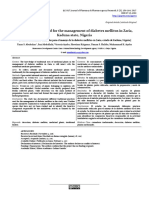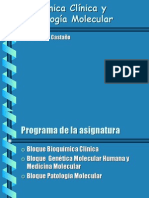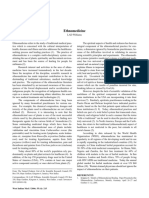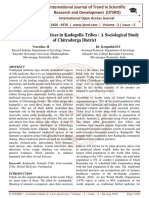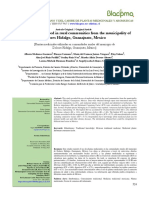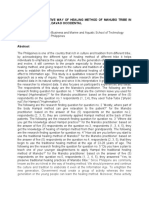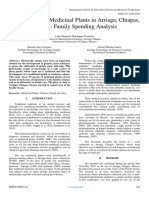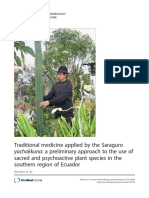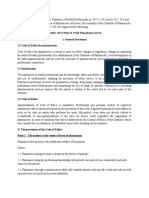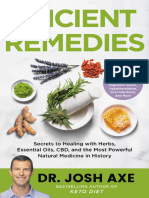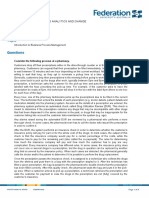Professional Documents
Culture Documents
Medicinal Plants: Habitus in Chamula, Chiapas, Mexico S. XXI
Uploaded by
Anonymous izrFWiQOriginal Title
Copyright
Available Formats
Share this document
Did you find this document useful?
Is this content inappropriate?
Report this DocumentCopyright:
Available Formats
Medicinal Plants: Habitus in Chamula, Chiapas, Mexico S. XXI
Uploaded by
Anonymous izrFWiQCopyright:
Available Formats
Volume 4, Issue 8, August – 2019 International Journal of Innovative Science and Research Technology
ISSN No:-2456-2165
Medicinal Plants: Habitus in Chamula,
Chiapas, Mexico S. XXI
Ivett Reyes-Guillén Socorro Fonseca-Córdoba Ramón Mariaca-Méndez
Faculty of Social Sciences. Faculty of Social Sciences. The College of the Southern Frontier,
Autonomous University of Chiapas Autonomous University of Chiapas ECOSUR
San Cristobal de Las Casas San Cristobal de Las Casas San Cristobal de Las Casas
Chiapas, Mexico Chiapas, Mexico Chiapas
Abstract:- This article presents the results of a study Both in the Eastern world and in Latin American
conducted in Chamula, indigenous people of Chiapas, countries, the practice of alternative medicine or
Mexico. The study aimed to learn about the use of complementary medicine is common, among which
medicinal plants as practices that have remained over herbalism stands out. In Chiapas, Mexico, Mayan culture
time. In Chiapas, the Mayan culture exposes this exposes this knowledge in customs and customs, and
knowledge in customs and customs, and specifically in specifically in health self-care.
self-care of health. Indigenous peoples have developed
these medical uses and customs through the knowledge The World Health Organization, traditional medicine
of the human body, coexistence with their environment, is the set of knowledge, skills and practices for health
spirituality inserted into the magical-religious world. maintenance, based on indigenous theories, beliefs and
Among the main findings: 1) The most commonly used experiences of different cultures (WHO, 2017). Within
plants are chamomile (Chamomilla recutita), lemon tea traditional medicine in Chiapas, there are countless medical
(Cymbopogon citratus), and linden tea (Tilia expressions, from the herbs who practice herbalism; the
platyphyllos). 2) The main health problems that are snoopers who practice empirical chiropraxia; pushbuttons
treated with medicinal plants are: diseases or digestive with magical-religious strategies; to midwives in charge of
disorders (45%), respiratory problems (37%), nervous midwives and those most often linked to Western medicine
system disturbances (35%), circulatory (27%) or through training courses.
reproductive (26%).3) In the second decade of the 21st
century, traditional medicine practices are cultural While it is true that health systems are cautious about
fields, objectively constructed with habitus that mark the validity of traditional medical practices, it is also true
lifestyles in socially classified system. that international health agencies are increasingly
advocating the rescue of traditional knowledge, as well as
Keywords:- Herbalism, Chiapas, Traditional Practices. linkage between the two types of knowledge. In this regard,
Vázquez and collaborators (2011), state that specifically
I. INTRODUCTION traditional knowledge and practice on medicinal plants is in
force; that is, knowledge continues to be transmitted and
Throughout history, humanity has developed different practiced in this type of medicine for self-care.
forms of use, cultivation and transmission of knowledge
concerning medicinal plants, i.e. it has accumulated The articulation efforts between traditional and
knowledge on therapeutic strategies related to the world western hegemonic systems are not horizontal and open,
magical-religious of different cultures, based at all times on emphasizing the biomedical side in the process of
the empirical rational method and even brought to the validation and scientific translation of traditional
scientific method. medicines, which is ultimately assimilation of indigenous
traditional knowledge (Bolívar y Reyes, 2009).
Herbal medicine is defined as the therapeutic use of a
product derived from a plant or herb, valued for its This document presents results of a study carried out
medicinal properties, taste or aromatic qualities (Barnes, in Chamula, Chiapas, Mexico, an indigenous population
2003). whose practices within traditional medicine continue to be
part of the cultural legacy of their generations. Indigenous
Specifically, herbalism includes the use of substances peoples have developed these medical uses and customs
extracted from herbs, which are prepared in the form of tea, through the knowledge of the human body, coexistence
ointments, bathing water, lotions, soaps, oils. Within with their environment, spirituality inserted into the
traditional empirical practices, these are not evaluated and magical-religious world. In this regard, the Pan American
approved by government regulatory bodies; but that does Health Organization (2001) mentions the strength and
not exempt the pharmaceutical company within the capacity of indigenous peoples as a result of the
processed herbal medicine to approve its use and marketing effectiveness of their traditional health system, whose
through so-called naturist pharmacies (Carrillo et al, 2010). worldview is based on balance, harmony and integrity.
IJISRT19AUG862 www.ijisrt.com 520
Volume 4, Issue 8, August – 2019 International Journal of Innovative Science and Research Technology
ISSN No:-2456-2165
The municipality of Chamula, in Chiapas, is located in The knowledge that different ethnic groups have of
the north-central part of the state. It is part of the Tzeltal- their environment and the uses and customs related to it has
Tzotzil Region of the Altos de Chiapas, characterized by its generated millennial knowledge, transcending by
mountainous geography, pine forest and ethnic-cultural generations and even being more specific over time.
diversity. It has an extension of 345 665 km2. Its extreme Contrary to what Gluber (2000) mentions, the young
coordinates are 16o 44' - 16o 54' north latitude and 92o 31' population of Chamula, Chiapas, continues to make use of
- 92o 52' west longitude and its altitude fluctuates between medicinal plants; He grows them; they are participants in a
a maximum of 3,000 and a minimum of 1 200 meters above collective identity, of uses and customs typical of the
sea level. Chamula has 76,941 inhabitants, of which 35,555 Tzotzil ethnic group. Specifically, in health, they are
are men and 41,386 women (INEGI, 2010). participants in the coexistence of traditional medicine and
allopathic medicine.
II. METHODS
Contrary to what Rodriguez mentions (2009), in this
Qualitative observational and cross-sectional research, study there was no difference in the knowledge and use of
the information-gathering tool of which was a semi- medicinal plants between men and women; neither was
structured questionnaire applied to a simple random sample there in terms of age of the interviewee.
n=100, in a Mayan indigenous population called Chamula,
located in the Tzeltal-Tzotzil Zone in the highlands of Within this study, the interviewees mentioned 23
Chiapas, Mexico, in a period from November 2018 to June different species of plants for medicinal use, within them in
2019. order of frequency mostly consumed in tea preparation are:
chamomile tea (21%), lemon tea (14%), tila tea (14%).
The questionnaire was applied prior to informed Most respondents claim to use herbal medicine frequently
consent, having as the only element of inclusion that the instead of allopathic medicine (74%). Regarding
individual was of indigenous origin tzotzil. chamomile (Chamomilla recutita), it has been of common
use worldwide for its healing characteristics, specifically in
III. DISSCUTION gastric diseases of infectious type, antiparasitic,
antispasmodic, defrosting and healing (Osuna, 2005; Mile,
From the results obtained we can discuss two 2008; Urióstegui-Flores, 2014; Ecoherbes, 2015).
moments, one regarding the permanence in the use of
medicinal plants through generations in the study Lemon tea (Cymbopogon citratus), has moisturizing
population. The other time is intended to discuss the main and diuretic properties, as well as antispasmodic, anti-
health problems for which they choose to treat them inflammatory, antioxidant (MS, 2015). Tila tea (Tilia
completely with herbal medicine, or complementary platyphyllos) has diaphoretic, deinflammatory, diuretic,
treatment to allopathic medicine. digestive and relaxing-sleeper properties (Escamilla and
Moreno, 2015).
Permanence in the use of medicinal plants through
generations in Chamula Chiapas, Mexico The other species mentioned, although less frequently
The average age of the population surveyed is 35 are:
years (min 18-max 86, fashion 20), in equal proportions in
terms of biological sex (men and women), 100% of Garlic (Allium sativum)
indigenous origin and bilingual tsotsil-Spanish. Mostly Basil (Ocimum basilicum)
married (64%). Anis (Pimpinella anisum)
Boldo (Peumus boldus)
The total number of interviewees consume teas and Cinnamon (Cinnamomum verum)
use herbal medicine by going to the institutional doctor Onion (Allium strain)
only if the health problem becomes complicated and no
Chilchahua (Tagetes nelsonii)
longer manage to control it. The above coincides with
Comino (Cuminum cyminum)
Gómez (2012) and Escalona et al (2015), who claim that
Epazote (Chenopodium ambrosioides)
most of the people interviewed in their study obtain
medicinal plants in the community itself and even grow Hierbabuena (Mentha spicata)
them. In these studies, the percentage (90%) is high people Hinojo (Foeniculum vulgare)
who solve their conditions with medicinal plants and only Ginger (Zingiber officinale)
go to the doctor when the affectation is severe. Laurel (Laurus nobilis)
Parsley (Petroselinum sativum)
About how they know how they use plants to treat Pepper (Piper nigrum)
some health problems, respondents claim to have this Oak (Quercus robur)
knowledge because their grandparents, mothers, family Romero (Rosmarinus officinalis)
members, and even friends have taught them. Knowing the Ruda (Graveolens Route)
most frequent age range (18-20 years), the user population Sabyla (Aloe vera)
is young, and checks the transfer of knowledge in the use of Thyme (Thymus vulgaris)
medicinal plants from generation to generation.
IJISRT19AUG862 www.ijisrt.com 521
Volume 4, Issue 8, August – 2019 International Journal of Innovative Science and Research Technology
ISSN No:-2456-2165
This population grows or collects the medicinal plants The above, show us in a reality where conflicts are
it uses by 65%, in a small percentage they buy them in the generated between the different types of medicine, the
market or in health food stores. It is precisely because of Western, traditional, alternative. When asked specifically,
this practice, living in many mainly Latino cultures, that 88% say they stop taking allopathic medications and
FAO (2005) proposes the family garden as an appropriate replace them with medicinal plants. While studies have
alternative for families to produce and consume at low cost been conducted on the contradiction between these medical
fresh, healthy, solvent products some of your needs and practices and hegemonic medicine, we also find that
preferences. The garden must generate products such as herbalism has become more meaningful due to discoveries
vegetables, edible, aromatic and medicinal plants. about the healing properties of some species such as are the
white zapote (Casimira edulis) for the treatment of high
As for the expense they consider making monthly for blood pressure; the nopal (Opuntia streptacantha) in the
the use of these plants, it goes in a range of 60 to 280 treatment of diabetes (Rivera, 1999; Uriostégui-Flores,
Mexican pesos (3-15 DLS/USA). Some studies claim that 2008; Oliva-Peña, 2017).
the preference in the use of medicinal plants by the
population is related by low costs, easy access, side effects IV. CONCLUSION
that are minor or null, compared to allopathic medicine
(Delpino, 2011; Lima, 2012). Interviewees use herbal medicine for self-care health go
to the allopathic doctor only if the health problem
Main health problems for which they choose to treat becomes complicated and they no longer manage to
them completely with herbal medicine, or control it.
complementary treatment to allopathic medicine The most commonly used plants are chamomile
Among the main health problems that are treated with (Chamomilla recutita), lemon tea (Cymbopogon
medicinal plants, in order of frequency are: diseases or citratus), and tila tea (Tilia platyphyllos)
digestive disorders (45%), respiratory problems (37%), The main health problems that are treated with
nervous system disorders (35%), circulatory (27%) or medicinal plants are: diseases or digestive disorders
reproductive (26%), the remaining percentage corresponds (45%), respiratory problems (37%), nervous system
to another wide variety of occasions when they use these disorders (35%), circulatory (27%) reproductive it
plants, such as bone pain, depurative baths, cosmetic use. (26%).
Having quoted Malinowsky (1948) and Bourdieu
Specific mention should be made that, of the total (1988) before, we can affirm that the world of
number of interviewees, most use this type of plants with traditional medicine, in this case herbalism, in Chamula,
healing characteristics within a magical-religious Chiapas, Mexico, is a habitus and these are developed
framework, that is, not only consume them, but they do so in a continuum through the generations. In the 21st
accompanied by a series of rituals of healing involving century, the end of the second decade, traditional
spiritual, magical, religious aspects. 88% of respondents medicine practices are cultural fields, objectively
make use of different types of traditional medicine through constructed with habitus that mark lifestyles in socially
so-called hierberos, pulsadores, sobadores, midwives. classified systems.
These practices are always associated with beliefs in REFERENCES
supernatural forces, quoting Malinowsky (1948), with ideas
about beings, spirits, ghosts, dead ancestors, or gods; [1]. Barnes J. Quality, efficacy and safety of
although these practices, however primitive, could not be complementary medicines:fashions, facts and the
invented or maintained without the observation of natural future. Part II: Efficacy and safety. Br J Clin
processes and without a firm belief in their regularity, Pharmacol 2003; 55: 331-40.
without the power to reason and without the confidence in [2]. Bolívar, E. & Reyes, G. Et al. (2009). Medicinas y
the power of reason. encuentros heterogéneos: una mirada hacia el
conflicto y el diálogo de saberes. En: Diálogo de
For indigenous groups, such as tzotziles interviewed saberes: plantas medicinales, salud y cosmovisiones.
in this study, nature is a living pantry that they turn to Universidad Nacional de Colombia, Sede Amazonia;
collect food, cook, eat and even heal. The route from nature Bogotá: ARFO Editores e Impresos Ltda.
to the stomach in these ethnic groups is very short; [3]. Bourdieu, P. (1988). La distinción. Criterios y bases
Malinowsky (1948) points out that, consequently, it is also sociales del gusto. Madrir: Taurus.
so much up to his mind, and the world, for these groups, is [4]. Carrillo R E, Bolivar LC, JM Ruiz. (2010). Hierbas,
an abundant warehouse from which species of plants and medicina herbolaria y su impacto en la práctica
animals that are useful stand out. Cultural fields are then clínica. Rev Invest Med Sur Mex, Julio-septiembre
generated, closely related to their environmental 2010; 17 (3): 124-130
environment and health care needs; understanding as a field [5]. Delpino, GB. (2011). Simbologia do uso de plantas
what Bourdieu (1988), defines as historically constituted medicinais por agricultores familiares descendentes de
spaces of play, with its specific institutions and its own pomeranos no sul do Brasil. 2011. Dissertação
operating laws. (mestrado em enfermagem) – Universidade Federal de
Pelotas, Pelotas, 2011.
IJISRT19AUG862 www.ijisrt.com 522
Volume 4, Issue 8, August – 2019 International Journal of Innovative Science and Research Technology
ISSN No:-2456-2165
[6]. Ecoherbes. (2015). La Manzanilla y sus beneficios en [22]. Rodríguez GY, Carballo AL, Geada LG, Flores JL y
nuestra salud. Consultado en: PL Páez Fernández. (2009). Plantas medicinales como
https://www.ecoherbes.com/es/manzanilla-beneficios/ productos forestales no maderables en el ecosistema
[7]. Escalona et al. (2015). Uso tradicional de plantas forestal del Parque Nacional Viñales. CIGET
medicinales por el adulto mayor en la comunidad [23]. Urióstegui-Flores A. (2008). Conflictos en el empleo
serrana de Corralillo Arriba. Guisa, Granma. Revista de medicina tradicional. REGIÓN Y SOCIEDAD /
Cubana de Plantas Medicinales 2015;20(4)429-439 VOL. XX / NO. 43. 2008
[8]. Escamilla y Moreno. (2015). Plantas medicinales. [24]. Urióstegui-Flores A. (2014). Hierbas medicinales
Instituto de Ecología AC. Xalapa, Veracruz, México. utilizadas en la atención de enfermedades del sistema
[9]. FAO. Organización de las Naciones Unidas para la digestivo en la ciudad de Taxco, Guerrero, México.
Agricultura y la Alimentación (2005). Manejo del Revista de Salud Pública (2015),17(1):85.
Huerto Integrado. Consultado en: http://dx.doi.org/10.15446/rsap.v17n1.42235
http://www.fao.org/3/a-at761s.pdf [25]. Vázquez, B., Martínez, B., Aliphat, M. & Aguilar, A.
[10]. Gómez Álvarez R. Plantas medicinales en una aldea (2011). Uso y conocimiento de plantas medicinales
del estado de Tabasco, México. Rev Fitotec Mex. por hombres y mujeres en dos localidades indígenas
2012;35(1). en Coyomeapan, Puebla, México. VOL. 36 Nº7:
[11]. Gubler, R. (2000). Antiguos documentos de medicina INTERCIENCIA.
Maya. Anales de Antropología 34; 321-349.
[12]. INEGI. Instituto Nacional de Estadística y Geografía
(2010). Compendio de información geográfica
municipal 2010. Chamula, Chiapas.
[13]. Lima, ARA. (2012). Agricultoras no cuidado da
família com uso das plantas medicinais. 2012.
Dissertação (mestrado em enfermagem) –
Universidade Federal de Pelotas, Pelotas, 2012.
[14]. Malinowsky, B. (1948). Magia, ciencia y religión.
Planeta-Agostini. Antonio Pérez Ramos, traducción.
[15]. Milla, KE. (2008). IBEROFORUM Revista de
Ciencias Sociales de la Universidad Iberoamericana.
Año III, No 6. julio- diciembre de 2008. Pp. 37-57
Universidad Iberoamericana A.C., Ciudad de México.
[16]. MS. Muy en salud. (2015). Propiedades medicinales
del Zacate Limón (Limoncillo). Consultado en:
https://muyensalud.com/2015/04/propiedades-
medicinales-de-zacate-de-limon-limoncillo/
[17]. Oliva-Peña y, Andueza-Pech MG, Rodríguez-Angulo
em y r Ojeda-Rodríguez. (2017). conocimientos y
usos de plantas medicinales en adolescentes de
Yucatán. Revista de Ciencias de la Salud. 2017. 4-13:
30-34.
[18]. OPS. Serie salud de los Pueblos Indígenas No. 18:
Promoción de la medicina y práctica indígenas en la
atención primaria de salud: el caso de los Quechua del
Perú. OPS, 2001.
[19]. Organización Mundial de la Salud. (2017).
Recuperado el 7 de agosto de 2017 de:
http://www.who.int/topics/traditional_medicine/defini
tions/es/
[20]. Osuna Torres, L., Tapia M. y Aguilar Contreras A.
(2005), Plantas medicinales de la medicina tradicional
mexicana para tratar afecciones gastrointestinales:
Estudio etnobotánico, fitoquímico y farmacológico.
Barcelona, Universitat de Barcelona.
[21]. Rivera E. Investigación reciente sobre plantas
medicinales mexicanas. En: Arqueología mexicana,
plantas medicinales prehispánicas. México: Editorial
Raíces-Instituto Nacional de Arqueología e Historia.
1999; VII (39)
IJISRT19AUG862 www.ijisrt.com 523
You might also like
- Hoja de Guayaba PDFDocument12 pagesHoja de Guayaba PDFpsantiagohdzNo ratings yet
- Medicinal Plants Used For The Management of Diabetes Mellitus in Zaria, Kaduna State, NigeriaDocument9 pagesMedicinal Plants Used For The Management of Diabetes Mellitus in Zaria, Kaduna State, NigeriaJournal of Pharmacy & Pharmacognosy ResearchNo ratings yet
- Legislación de Productos Herbolarios.Document9 pagesLegislación de Productos Herbolarios.Fede FerNo ratings yet
- Antes de Fauchard - 1Document11 pagesAntes de Fauchard - 1Itzel Loyola ValenciaNo ratings yet
- Bioquímica Clínica y Patología Molecular GuíaDocument134 pagesBioquímica Clínica y Patología Molecular GuíaDenysse Liliana Caroca Dávila50% (2)
- Hierbas MedicinalesDocument24 pagesHierbas MedicinalesDaniela Liberona0% (1)
- Bertholletia excelsa seed benefits and risks for obesityDocument16 pagesBertholletia excelsa seed benefits and risks for obesityCloud StrNo ratings yet
- Plantas Medicinales Roberto ChiejDocument225 pagesPlantas Medicinales Roberto ChiejChazar Frs FrsNo ratings yet
- Sensibilidad y Especificidad Del Gammagrama Ciprofloxacino-Tc99M Sensibilidad y Especificidad en Osteomielitis Infantil (AOM 2010)Document4 pagesSensibilidad y Especificidad Del Gammagrama Ciprofloxacino-Tc99M Sensibilidad y Especificidad en Osteomielitis Infantil (AOM 2010)Simon ChangNo ratings yet
- Baccharis Latifolia - Chilca PDFDocument4 pagesBaccharis Latifolia - Chilca PDFCatalina FríasNo ratings yet
- Herbal Remedies for Diabetes Common in TrinidadDocument6 pagesHerbal Remedies for Diabetes Common in Trinidadcrema79No ratings yet
- ToxicologiaDocument84 pagesToxicologiaBella de la Ross100% (1)
- 0000Document135 pages0000Lizbeth Mar ToNo ratings yet
- Polylepis Forests of the Central AndesDocument11 pagesPolylepis Forests of the Central AndesJunior Mendoza PorrasNo ratings yet
- Phytochemical Analysis and Antibacterial Activity On Seed and Pod Extracts of Crotalaria IncanaDocument9 pagesPhytochemical Analysis and Antibacterial Activity On Seed and Pod Extracts of Crotalaria IncanaJournal of Pharmacy & Pharmacognosy ResearchNo ratings yet
- Farma 2Document81 pagesFarma 2Ale AguilarNo ratings yet
- Ethnopharmacology of Ska María PastoraDocument20 pagesEthnopharmacology of Ska María PastoraContrain Formante CRNo ratings yet
- Plant AsDocument66 pagesPlant AsaleikaNo ratings yet
- Dialnet TomilloThymusVulgarisL 202456 PDFDocument3 pagesDialnet TomilloThymusVulgarisL 202456 PDFTomz Fernández MedinaNo ratings yet
- Medicinal Plants in Comitan, Chiapas, Mexico: CustomsDocument3 pagesMedicinal Plants in Comitan, Chiapas, Mexico: CustomsInternational Journal of Innovative Science and Research TechnologyNo ratings yet
- 198-Texto Del Artículo-391-1-10-20210503Document14 pages198-Texto Del Artículo-391-1-10-20210503Luis SalcedoNo ratings yet
- Usos Tradicionales de Las Plantas Medicinales en LDocument34 pagesUsos Tradicionales de Las Plantas Medicinales en LloschiavopNo ratings yet
- BUSSMANN Rainer, SHARON Douglas - Traditional Medicinal Plant Use in Northern Peru Tracking Two Thousand Years of Healing Culture - 2006Document18 pagesBUSSMANN Rainer, SHARON Douglas - Traditional Medicinal Plant Use in Northern Peru Tracking Two Thousand Years of Healing Culture - 2006ninkasi1No ratings yet
- Plantas Medicinales BoliviaDocument17 pagesPlantas Medicinales BoliviaNatalia Alejandra Gonzalez Sanchez100% (1)
- 1.1 Background of The StudyDocument11 pages1.1 Background of The StudyfaithNo ratings yet
- Espole-Muhat FinalexamDocument16 pagesEspole-Muhat FinalexamJaja Jr. Evasco EmbarqueNo ratings yet
- Exploring the Cultural and Spiritual Dimensions of EthnomedicineDocument2 pagesExploring the Cultural and Spiritual Dimensions of Ethnomedicineiman14No ratings yet
- Bioknowledgy of the Ecuadorian Flora. Some medicinal plants and their uses.From EverandBioknowledgy of the Ecuadorian Flora. Some medicinal plants and their uses.No ratings yet
- Plantas Con Madre Plants That Teach and PDFDocument15 pagesPlantas Con Madre Plants That Teach and PDFJetNo ratings yet
- An Exploration of The Ethno-Medicinal Practices Among Traditional Healers in Southwest Cebu, PhilippinesDocument7 pagesAn Exploration of The Ethno-Medicinal Practices Among Traditional Healers in Southwest Cebu, PhilippinesleecubongNo ratings yet
- Ethnobotany of Medicinal Plants Used in Xalpatlahuac, Guerrero, MéxicoDocument7 pagesEthnobotany of Medicinal Plants Used in Xalpatlahuac, Guerrero, MéxicoEmmanuel Torre ArenasNo ratings yet
- Guía Didáctica de Plantas Medicinales de Los Pueblos Indígenas Del CantónDocument22 pagesGuía Didáctica de Plantas Medicinales de Los Pueblos Indígenas Del CantónfesooNo ratings yet
- Medicinal Plants of The Subanens in Dumingag, Zamboanga Del Sur, PhilippinesDocument6 pagesMedicinal Plants of The Subanens in Dumingag, Zamboanga Del Sur, PhilippinesElijah AlamilloNo ratings yet
- Ethnobiology of Tharu People of KanchanpDocument5 pagesEthnobiology of Tharu People of KanchanpPabloDarlanNo ratings yet
- Raji Tribe11Document12 pagesRaji Tribe11Keya PandeyNo ratings yet
- Thesis JielDocument14 pagesThesis JielMary Jiel Dionesio LansanganNo ratings yet
- THE PREPPER'S GUIDE TO NATURAL MEDICINE: Herbal Remedies, Essential Oils, and Healing Practices for Preparedness (2023 Beginner Crash Course)From EverandTHE PREPPER'S GUIDE TO NATURAL MEDICINE: Herbal Remedies, Essential Oils, and Healing Practices for Preparedness (2023 Beginner Crash Course)No ratings yet
- Tribal Medicine Practices in Kadugolla Tribes: A Sociological Study of Chitradurga DistrictDocument4 pagesTribal Medicine Practices in Kadugolla Tribes: A Sociological Study of Chitradurga DistrictEditor IJTSRDNo ratings yet
- Indigenous knowledge of medicinal plants used by Yogad peopleDocument28 pagesIndigenous knowledge of medicinal plants used by Yogad peopleKecilyn AmbrocioNo ratings yet
- 1 PB PDFDocument19 pages1 PB PDFKharen Domacena DomilNo ratings yet
- DocumentDocument3 pagesDocumentSteve OpenNo ratings yet
- Toledo Etnobiologia de Los GuaraniesDocument14 pagesToledo Etnobiologia de Los GuaraniesElizabeth Melgarejo EstradaNo ratings yet
- 2023 Bol Latinoam Caribe Plant Med Aroma 22, 524-536Document13 pages2023 Bol Latinoam Caribe Plant Med Aroma 22, 524-536Saul MuñozNo ratings yet
- Healing Practices and Alternative Medicines of Panay Bukidnon in Selected Upland Communities in Tapaz, CapizDocument25 pagesHealing Practices and Alternative Medicines of Panay Bukidnon in Selected Upland Communities in Tapaz, CapizRenwen LataNo ratings yet
- NLPMD Undergrad - Concept Paper Ethnobotanical Study of Medicinal Plants Used by Yogad People of Echague Isabela Science Research 1 3BSciEdDocument8 pagesNLPMD Undergrad - Concept Paper Ethnobotanical Study of Medicinal Plants Used by Yogad People of Echague Isabela Science Research 1 3BSciEdKecilyn AmbrocioNo ratings yet
- Cabuyoc, Jelicel FaithDocument8 pagesCabuyoc, Jelicel FaithRhea May T. Delos SantosNo ratings yet
- Knowledge On Traditional Medicine at The Mah Meri Settlement, Pulau Carey, SelangorDocument48 pagesKnowledge On Traditional Medicine at The Mah Meri Settlement, Pulau Carey, SelangorSnorlax iNo ratings yet
- Herbal Medicine Research PaperDocument24 pagesHerbal Medicine Research PaperleahNo ratings yet
- Medical Pluralism Among The Tharus of Nepal: Legitimacy, Hierarchy and State PolicyDocument9 pagesMedical Pluralism Among The Tharus of Nepal: Legitimacy, Hierarchy and State PolicyBamdev SubediNo ratings yet
- Traditional Medicine in The Health Systems of Communities: A First Exploring in Veracruz State, MexicoDocument18 pagesTraditional Medicine in The Health Systems of Communities: A First Exploring in Veracruz State, MexicoMamta AgarwalNo ratings yet
- The Practice of Using Medicinal Plants by Local Herbalists in Cavite, PhilippinesDocument9 pagesThe Practice of Using Medicinal Plants by Local Herbalists in Cavite, PhilippinesRao SrinivasNo ratings yet
- Frequently Used Medicinal Plants in Arriaga, Chiapas, Mexico: Family Spending AnalysisDocument3 pagesFrequently Used Medicinal Plants in Arriaga, Chiapas, Mexico: Family Spending AnalysisInternational Journal of Innovative Science and Research TechnologyNo ratings yet
- Albularyo Folk Healing: Cultural Beliefs On Healthcare Management in Partido District, Camarines Sur, PhilippinesDocument28 pagesAlbularyo Folk Healing: Cultural Beliefs On Healthcare Management in Partido District, Camarines Sur, PhilippinesANGELICA AYCARDO FLORESNo ratings yet
- Traditional Medicinal Plants of Nigeria: An Overview: Monier M. Abd El-GhaniDocument28 pagesTraditional Medicinal Plants of Nigeria: An Overview: Monier M. Abd El-GhaniOyediran OlabamijiNo ratings yet
- Medical ManuscriptDocument8 pagesMedical ManuscriptEstefanny EstroniloNo ratings yet
- BotánicaDocument13 pagesBotánicaDiego QuiñonezNo ratings yet
- The Devil's Fruit: Farmworkers, Health, and Environmental JusticeFrom EverandThe Devil's Fruit: Farmworkers, Health, and Environmental JusticeNo ratings yet
- Ethno-Botanical Study of Medicinal Plants Used by The Yucatec Maya in The Northern District of BelizeDocument10 pagesEthno-Botanical Study of Medicinal Plants Used by The Yucatec Maya in The Northern District of BelizeDaviqBagusSetiadiNo ratings yet
- Reproductive Medicine in Northwest Argentina: Traditional Andinstitutional SystemsDocument23 pagesReproductive Medicine in Northwest Argentina: Traditional Andinstitutional SystemsBiblioteca Perito Francisco P. Moreno.ArgentinaNo ratings yet
- Journal of Ethnobiology and EthnomedicineDocument22 pagesJournal of Ethnobiology and EthnomedicineHrafnaet SorgenNo ratings yet
- Analysis of Ancol Beach Object Development Using Business Model Canvas ApproachDocument8 pagesAnalysis of Ancol Beach Object Development Using Business Model Canvas ApproachAnonymous izrFWiQNo ratings yet
- Teacher Leaders' Experience in The Shared Leadership ModelDocument4 pagesTeacher Leaders' Experience in The Shared Leadership ModelAnonymous izrFWiQNo ratings yet
- Design and Analysis of Humanitarian Aid Delivery RC AircraftDocument6 pagesDesign and Analysis of Humanitarian Aid Delivery RC AircraftAnonymous izrFWiQNo ratings yet
- Knowledge and Utilisation of Various Schemes of RCH Program Among Antenatal Women and Mothers Having Less Than Five Child in A Semi-Urban Township of ChennaiDocument5 pagesKnowledge and Utilisation of Various Schemes of RCH Program Among Antenatal Women and Mothers Having Less Than Five Child in A Semi-Urban Township of ChennaiAnonymous izrFWiQNo ratings yet
- Bioadhesive Inserts of Prednisolone Acetate For Postoperative Management of Cataract - Development and EvaluationDocument8 pagesBioadhesive Inserts of Prednisolone Acetate For Postoperative Management of Cataract - Development and EvaluationAnonymous izrFWiQNo ratings yet
- Women in The Civil Service: Performance, Leadership and EqualityDocument4 pagesWomen in The Civil Service: Performance, Leadership and EqualityAnonymous izrFWiQNo ratings yet
- Incidence of Temporary Threshold Shift After MRI (Head and Neck) in Tertiary Care CentreDocument4 pagesIncidence of Temporary Threshold Shift After MRI (Head and Neck) in Tertiary Care CentreAnonymous izrFWiQNo ratings yet
- Evaluation of Assessing The Purity of Sesame Oil Available in Markets of India Using Bellier Turbidity Temperature Test (BTTT)Document4 pagesEvaluation of Assessing The Purity of Sesame Oil Available in Markets of India Using Bellier Turbidity Temperature Test (BTTT)Anonymous izrFWiQNo ratings yet
- Investigations On BTTT As Qualitative Tool For Identification of Different Brands of Groundnut Oils Available in Markets of IndiaDocument5 pagesInvestigations On BTTT As Qualitative Tool For Identification of Different Brands of Groundnut Oils Available in Markets of IndiaAnonymous izrFWiQNo ratings yet
- Securitization of Government School Building by PPP ModelDocument8 pagesSecuritization of Government School Building by PPP ModelAnonymous izrFWiQNo ratings yet
- Platelet-Rich Plasma in Orthodontics - A ReviewDocument6 pagesPlatelet-Rich Plasma in Orthodontics - A ReviewAnonymous izrFWiQNo ratings yet
- Closure of Midline Diastema by Multidisciplinary Approach - A Case ReportDocument5 pagesClosure of Midline Diastema by Multidisciplinary Approach - A Case ReportAnonymous izrFWiQNo ratings yet
- Child Rights Violation and Mechanism For Protection of Children Rights in Southern Africa: A Perspective of Central, Eastern and Luapula Provinces of ZambiaDocument13 pagesChild Rights Violation and Mechanism For Protection of Children Rights in Southern Africa: A Perspective of Central, Eastern and Luapula Provinces of ZambiaAnonymous izrFWiQNo ratings yet
- Experimental Investigation On Performance of Pre-Mixed Charge Compression Ignition EngineDocument5 pagesExperimental Investigation On Performance of Pre-Mixed Charge Compression Ignition EngineAnonymous izrFWiQNo ratings yet
- A Wave Energy Generation Device Using Impact Force of A Breaking Wave Based Purely On Gear CompoundingDocument8 pagesA Wave Energy Generation Device Using Impact Force of A Breaking Wave Based Purely On Gear CompoundingAnonymous izrFWiQNo ratings yet
- IJISRT19AUG928Document6 pagesIJISRT19AUG928Anonymous izrFWiQNo ratings yet
- Enhanced Opinion Mining Approach For Product ReviewsDocument4 pagesEnhanced Opinion Mining Approach For Product ReviewsAnonymous izrFWiQNo ratings yet
- IJISRT19AUG928Document6 pagesIJISRT19AUG928Anonymous izrFWiQNo ratings yet
- Application of Analytical Hierarchy Process Method On The Selection Process of Fresh Fruit Bunch Palm Oil SupplierDocument12 pagesApplication of Analytical Hierarchy Process Method On The Selection Process of Fresh Fruit Bunch Palm Oil SupplierAnonymous izrFWiQNo ratings yet
- Risk Assessment: A Mandatory Evaluation and Analysis of Periodontal Tissue in General Population - A SurveyDocument7 pagesRisk Assessment: A Mandatory Evaluation and Analysis of Periodontal Tissue in General Population - A SurveyAnonymous izrFWiQNo ratings yet
- Assessment of Health-Care Expenditure For Health Insurance Among Teaching Faculty of A Private UniversityDocument7 pagesAssessment of Health-Care Expenditure For Health Insurance Among Teaching Faculty of A Private UniversityAnonymous izrFWiQNo ratings yet
- Comparison of Continuum Constitutive Hyperelastic Models Based On Exponential FormsDocument8 pagesComparison of Continuum Constitutive Hyperelastic Models Based On Exponential FormsAnonymous izrFWiQNo ratings yet
- Effect Commitment, Motivation, Work Environment On Performance EmployeesDocument8 pagesEffect Commitment, Motivation, Work Environment On Performance EmployeesAnonymous izrFWiQNo ratings yet
- SWOT Analysis and Development of Culture-Based Accounting Curriculum ModelDocument11 pagesSWOT Analysis and Development of Culture-Based Accounting Curriculum ModelAnonymous izrFWiQNo ratings yet
- Trade Liberalization and Total Factor Productivity of Indian Capital Goods IndustriesDocument4 pagesTrade Liberalization and Total Factor Productivity of Indian Capital Goods IndustriesAnonymous izrFWiQNo ratings yet
- Revived Article On Alternative Therapy For CancerDocument3 pagesRevived Article On Alternative Therapy For CancerAnonymous izrFWiQNo ratings yet
- Exam Anxiety in Professional Medical StudentsDocument5 pagesExam Anxiety in Professional Medical StudentsAnonymous izrFWiQ100% (1)
- Pharmaceutical Waste Management in Private Pharmacies of Kaski District, NepalDocument23 pagesPharmaceutical Waste Management in Private Pharmacies of Kaski District, NepalAnonymous izrFWiQNo ratings yet
- The Influence of Benefits of Coastal Tourism Destination On Community Participation With Transformational Leadership ModerationDocument9 pagesThe Influence of Benefits of Coastal Tourism Destination On Community Participation With Transformational Leadership ModerationAnonymous izrFWiQNo ratings yet
- To Estimate The Prevalence of Sleep Deprivation and To Assess The Awareness & Attitude Towards Related Health Problems Among Medical Students in Saveetha Medical CollegeDocument4 pagesTo Estimate The Prevalence of Sleep Deprivation and To Assess The Awareness & Attitude Towards Related Health Problems Among Medical Students in Saveetha Medical CollegeAnonymous izrFWiQNo ratings yet
- A Sample Report of Pharmacy TrainingDocument34 pagesA Sample Report of Pharmacy Trainingsaransh misra100% (2)
- Code of Ethics for Kosovo PharmacistsDocument4 pagesCode of Ethics for Kosovo PharmacistsElla MihNo ratings yet
- Case Study (HOSPITAL)Document4 pagesCase Study (HOSPITAL)Reyna Mee AhiyasNo ratings yet
- Concord Biotech Ltd-IPO NoteDocument11 pagesConcord Biotech Ltd-IPO NoteSabyasachi JenaNo ratings yet
- Drug Distribution System in A HospitalDocument18 pagesDrug Distribution System in A HospitalAnushka Mani tripathiNo ratings yet
- Manufacturing Pharmacy ADR DetectionDocument29 pagesManufacturing Pharmacy ADR Detectionheyyo ggNo ratings yet
- 9c5ff54e-92aa-4393-8350-218e91c128d2Document6 pages9c5ff54e-92aa-4393-8350-218e91c128d2Zarbakht AliNo ratings yet
- BTEC3 Dip Princs&Practice Pharmacy Technicians PrepubDocument320 pagesBTEC3 Dip Princs&Practice Pharmacy Technicians Prepubvunnava divyaNo ratings yet
- Ancient Remedies - DR Josh AxeDocument424 pagesAncient Remedies - DR Josh AxeLinh Nguyen100% (10)
- Adega Et Al.Document24 pagesAdega Et Al.Abe JosephNo ratings yet
- Itech 5404 01 TutorialDocument4 pagesItech 5404 01 TutorialKouser SultanaNo ratings yet
- Ta 3Document27 pagesTa 3Giang Kieu HoangNo ratings yet
- The Prevention of Intrathecal Medictionl Errors Woods K Department of Health UK 2001 PDFDocument24 pagesThe Prevention of Intrathecal Medictionl Errors Woods K Department of Health UK 2001 PDFArturo RuizNo ratings yet
- Temperature Mapping of Pharmaceutical VehiclesDocument3 pagesTemperature Mapping of Pharmaceutical VehiclesMohamed ZhranNo ratings yet
- Influenza (Flu) : What To Do If Your Child Gets Sick With The FluDocument4 pagesInfluenza (Flu) : What To Do If Your Child Gets Sick With The FluRosario De Jesus - GatchallanNo ratings yet
- Flu Drugs Exposed As A Waste of MoneyDocument3 pagesFlu Drugs Exposed As A Waste of MoneyIván VeranoNo ratings yet
- CCRP CourseDocument19 pagesCCRP CourseKathryn May0% (1)
- National Drug Policy 2016: English VersionDocument91 pagesNational Drug Policy 2016: English VersionAmena Jahan UrmyNo ratings yet
- Health10 - Q1 - Module1b (FOR TEACHER)Document26 pagesHealth10 - Q1 - Module1b (FOR TEACHER)AshleyNo ratings yet
- MUET Reading MidYear 2011Document16 pagesMUET Reading MidYear 2011deathmoonkiller86% (21)
- GEMS Medical AidDocument9 pagesGEMS Medical AidMike MajolaNo ratings yet
- ParoxetineDocument12 pagesParoxetinemarwa ammarNo ratings yet
- Focus On Nursing Pharmacology Karch 5th Edition Test BankDocument16 pagesFocus On Nursing Pharmacology Karch 5th Edition Test BankPeggie Edwards100% (30)
- LifeViroTreat - An Atma Nirbhar Bharat Innovation To Fight Corona Virus 1Document9 pagesLifeViroTreat - An Atma Nirbhar Bharat Innovation To Fight Corona Virus 1blogs414No ratings yet
- Porphyria Unsafe Drugs - Extensive ListDocument23 pagesPorphyria Unsafe Drugs - Extensive ListDorisStinson100% (1)
- Essentials of Medical Writing: Drug Discovery and Clinical ResearchDocument15 pagesEssentials of Medical Writing: Drug Discovery and Clinical ResearchanuNo ratings yet
- WEEK 6 PPT PainDocument22 pagesWEEK 6 PPT PainDanica FrancoNo ratings yet
- Fuqua Casebook 2019-2020 PDFDocument244 pagesFuqua Casebook 2019-2020 PDFSashi Shankar100% (7)
- MMA September 09 (L)Document36 pagesMMA September 09 (L)wlshakespeare0% (1)
- Medication TeachingDocument3 pagesMedication TeachingRS Sentra Medika CisalakNo ratings yet

